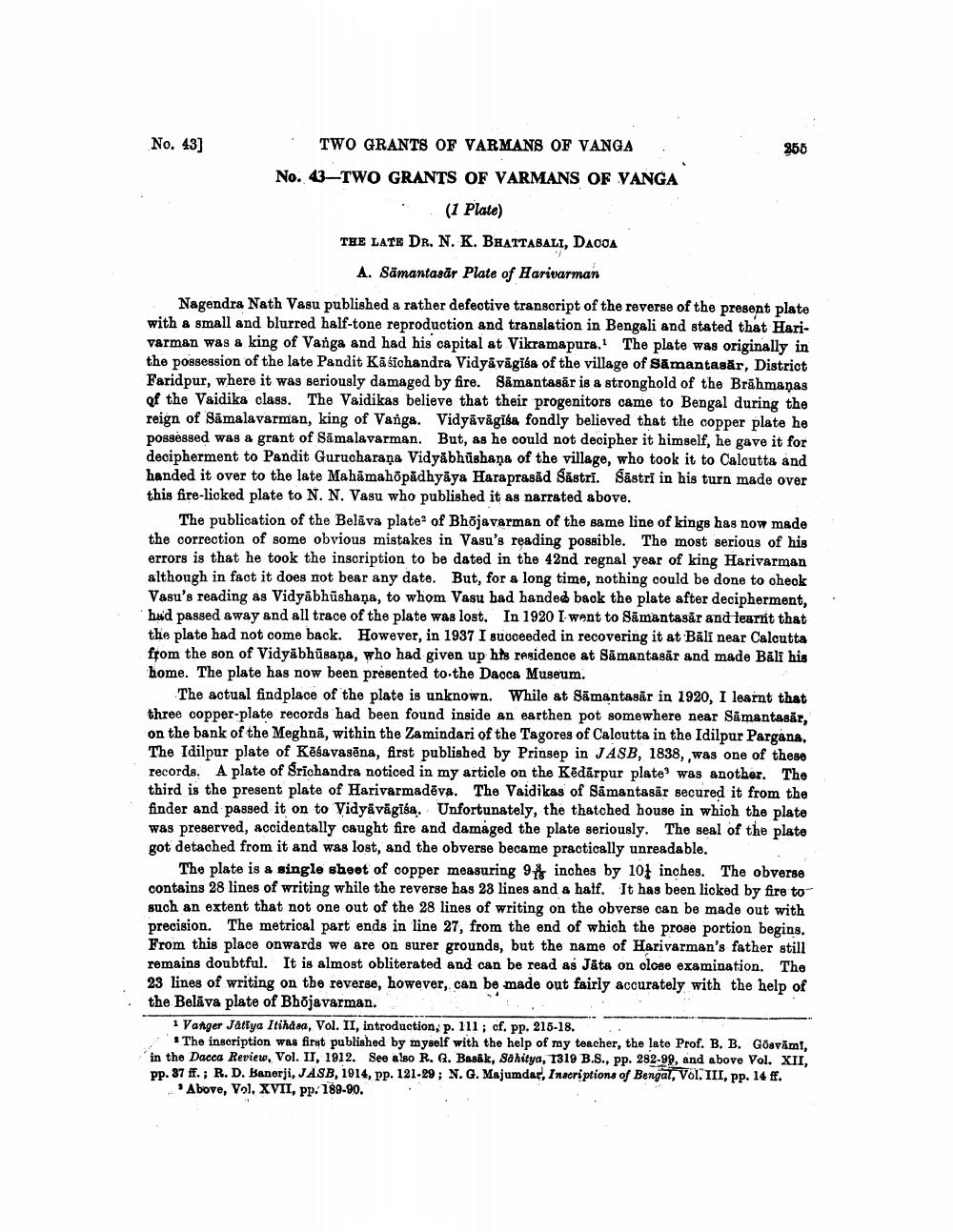________________
250
No. 43]
TWO GRANTS OF VARMANS OF VANGA No. 43–TWO GRANTS OF VARMANS OF VANGA
(1 Plate) THE LATE DR. N. K. BHATTABALI, DACOA
A. Samantasār Plate of Harivarman Nagendra Nath Vasu published a rather defective transcript of the reverse of the present plate with a small and blurred half-tone reproduction and translation in Bengali and stated that Harivarman was a king of Vanga and had his capital at Vikramapura. The plate was originally in the possession of the late Pandit Kasichandra Vidyāvägiba of the village of Samantasār, District Faridpur, where it was seriously damaged by fire. Samantasār is a stronghold of the Brāhmaṇas of the Vaidika class. The Vaidikas believe that their progenitors came to Bengal during the reign of Samalavarman, king of Vanga. Vidyāvāgisa fondly believed that the copper plate he possessed was a grant of Samalavarman. But, as he could not decipher it himself, he gave it for decipherment to Pandit Gurucharaṇa Vidyābhūshana of the village, who took it to Calcutta and handed it over to the late Mahämahopadhyāya Haraprasad Sāstri. Sāstri in his turn made over this fire-licked plate to N. N. Vasu who published it as narrated above.
The publication of the Belāva plate of Bhõjavarman of the same line of kings has now made the correction of some obvious mistakes in Vasu's reading possible. The most serious of his errors is that he took the inscription to be dated in the 42nd regnal year of king Harivarman although in fact it does not bear any date. But, for a long time, nothing could be done to check Vasu's reading as Vidyābhūshana, to whom Vasu bad handed back the plate after decipherment, had passed away and all trace of the plate was lost. In 1920 I went to Samantasar and learnt that the plate had not come back. However, in 1937 I succeeded in recovering it at Bāli near Calcutta from the son of Vidyābhūsana, who had given up hts residence at Sämantasär and made Bäli his home. The plate has now been presented to the Daoca Museum.
The actual findplace of the plate is unknown. While at Sämantasār in 1920. I learnt that three copper-plate records had been found inside an earthen pot somewhere near Sämant&săr, on the bank of the Meghnā, within the Zamindari of the Tagores of Caloutta in the Idilpur Pargana. The Idilpur plate of Kēšavasāna, first published by Prinsep in JASB, 1838,,was one of these records. A plate of Srichandra noticed in my article on the Kēdārpur plate was another. The third is the present plate of Harivarmadēva. The Vaidikas of Samantasar secured it from the finder and passed it on to Vidyavägisa. Unfortunately, the thatched house in which the plate was preserved, accidentally caught fire and damaged the plate seriously. The seal of the plate got detached from it and was lost, and the obverse became practically unreadable.
The plate is a single sheet of copper measuring 94 inches by 104 inches. The obverse contains 28 lines of writing while the reverse has 28 lines and a half. It has been licked by fire to such an extent that not one out of the 28 lines of writing on the obverse can be made out with precision. The metrical part ends in line 27, from the end of which the proge portion begins. From this place onwards we are on surer grounds, but the name of Harivarman's father still remains doubtful. It is almost obliterated and can be read as Jäta on olcse examination. The 23 lines of writing on the reverse, however, can be made out fairly accurately with the help of the Belāva plate of Bhõjavarman.
1 Vanger Jaliya Itihasa, Vol. II, introduction, p. 111; cf. pp. 215-18.
* The inscription was first published by myself with the help of my teacher, the late Prof. B. B. Gosvami, in the Dacca Review, Vol. II, 1912. See also R. G. Basāk, Sahitya, 1319 B.S., pp. 282-99, and above Vol. XII, Pp. 37 ff.; R. D. Banorji, JASB, 1914, pp. 121-29; N. G. Majumdar, Inscriptions of Bengal, Vol. III, pp. 14 ff.
Above, Vol. XVII, pp. 189-90.




